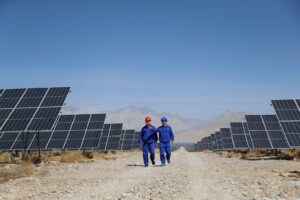
FOR IMMEDIATE RELEASE
Citizens’ Climate Lobby joins broad coalition supporting bipartisan Fix Our Forests Act
September 9, 2025 – Citizens’ Climate Lobby (CCL) has joined American Forests, the Bipartisan Policy Center Action, the Federation of American Scientists, and a range of other organizations to express support for the Fix Our Forests Act.
This broad coalition of 22 organizations sent a joint letter to Senate leadership, urging the bill’s passage through the Senate Committee on Agriculture, Nutrition and Forestry and then through the full Senate.
The letter details the growing risks from wildfires and the need to mitigate those threats. “Congress has the opportunity to take bipartisan action now, proactively, before the next fire inevitably costs lives, livelihoods, and ways of life,” the letter states.
Visit American Forests’ website to see the full letter and complete list of co-signing organizations.
CCL is also mobilizing our volunteer base to build more support for this legislation. This week, CCL launched a new action tool to generate grassroots messages to lawmakers on the Senate Committee on Agriculture, Nutrition and Forestry.
CONTACT: Flannery Winchester, CCL Vice President of Communications, 615-337-3642, flannery@citizensclimate.org
###
Citizens’ Climate Lobby is a nonprofit, nonpartisan, grassroots advocacy organization focused on national policies to address climate change. Learn more at citizensclimatelobby.org.
The post CCL joins broad coalition supporting bipartisan Fix Our Forests Act appeared first on Citizens' Climate Lobby.
CCL joins broad coalition supporting bipartisan Fix Our Forests Act
Greenhouse Gases
Factcheck: North Sea gas is not ‘four times cleaner’ than LNG imports
A claim that UK gas produced in the North Sea emits “four times” less carbon dioxide (CO2) than imported liquified natural gas (LNG) featured prominently in both the Guardian and the Daily Telegraph this week.
It came after Conservative leader Kemi Badenoch announced a pledge to drill “all” the remaining oil and gas in the North Sea, reigniting debates about new fossil-fuel production in the UK.
The claim that “UK gas is almost four times cleaner” than LNG imports was first made by a North Sea Transition Authority report in 2023 and is often repeated by senior Conservative politicians, as well as other public figures.
However, this figure is highly misleading.
It only refers to the emissions that come from the process of extracting and delivering the gas, which are much smaller than those from burning it.
When both extraction and burning of the gas are taken into account, CO2 emissions from UK production are only around 15% lower than those from LNG imports, Carbon Brief analysis shows.

Focusing on LNG imports alone is also misleading.
Official data shows that, from January to June 2025, the majority of UK gas imports came via pipeline from Norway.
Over this period, the UK imported 156,599 gigawatt hours (GWh) of gas from Norway via pipeline, the data shows. Its total LNG imports from all countries came to 82,378GWh.
An analysis published in 2022 found that, on average, emissions from extracting and processing gas in the UK North Sea are nearly three times higher than those from Norwegian production.
Previous analysis from the Climate Change Committee found that there is a small emissions “advantage” when UK oil and gas production is compared to the global average.
However, the CCC added that this emissions advantage would be wiped if increased production in the UK boosted global gas demand even fractionally, because it would lead to higher overall fossil-fuel use.
The UN Emissions Gap Report in 2023 said that the coal, oil and gas extracted over the lifetime of producing and under-construction mines and fields as of 2018 “would emit more than 3.5 times the carbon budget available” for meeting the Paris Agreement’s aim of keeping temperatures at 1.5C above pre-industrial levels.
The world’s highest international court recently gave a landmark opinion stating that granting new fossil-fuel exploration licences “may constitute an internationally wrongful act” attributable to the state issuing them.
This is based on a wide body of scientific evidence on how fossil-fuelled climate change has endangered people and ecosystems.
Output from the North Sea is already in decline. Oil production peaked in 1999, while gas production in the UK continental shelf peaked in 2000.
After decades of drilling, the majority of reserves left in the North Sea is oil. Contrary to claims that it would increase energy security or bring down bills to issue new licences, around 80% of oil produced in UK waters is currently exported to the global market.
The post Factcheck: North Sea gas is not ‘four times cleaner’ than LNG imports appeared first on Carbon Brief.
Factcheck: North Sea gas is not ‘four times cleaner’ than LNG imports
Greenhouse Gases
Guest post: China and India account for 87% of new coal-power capacity so far in 2025
China and India accounted for 87% of the new coal-power capacity put into operation in the first half of 2025, whereas other regions continued to move away from coal.
These developments, highlighting a growing global divide between many countries phasing out coal power and a handful continuing to expand new capacity, are revealed in Global Energy Monitor’s latest Global Coal Plant Tracker results and reported here for the first time.
The results include Ireland becoming the fifth EU country to phase out coal power and Latin America becoming a region with zero active proposals for new coal capacity.
Meanwhile, the results show the US is on track to retire more coal capacity in 2025 than it did under the Biden administration last year, despite the efforts of the Trump White House.
Moreover, rather than follow the US in turning away from clean-energy leadership, other countries have continued their efforts to phase down coal power, with “just energy transition partnerships” (JETPs) advancing in Vietnam, Indonesia and South Africa during 2025 to date.
EU and Latin America pave the way for coal phaseout
The EU and Latin America are emerging as the global leaders in phasing out coal power, according to GEM’s analysis.
On the heels of the UK coal phaseout in 2024, Ireland stopped the use of coal power in June 2025, with nine EU countries expected to follow suit through 2029, including Spain, France and the Netherlands.
In total, all but three EU countries are planning to phase out coal by 2033, as shown in the chart below.
According to the International Energy Agency (IEA), coal power should be virtually phased out in advanced economies by 2030 and the rest of the world by 2040 to keep warming below 1.5C, as the Paris Agreement targets.
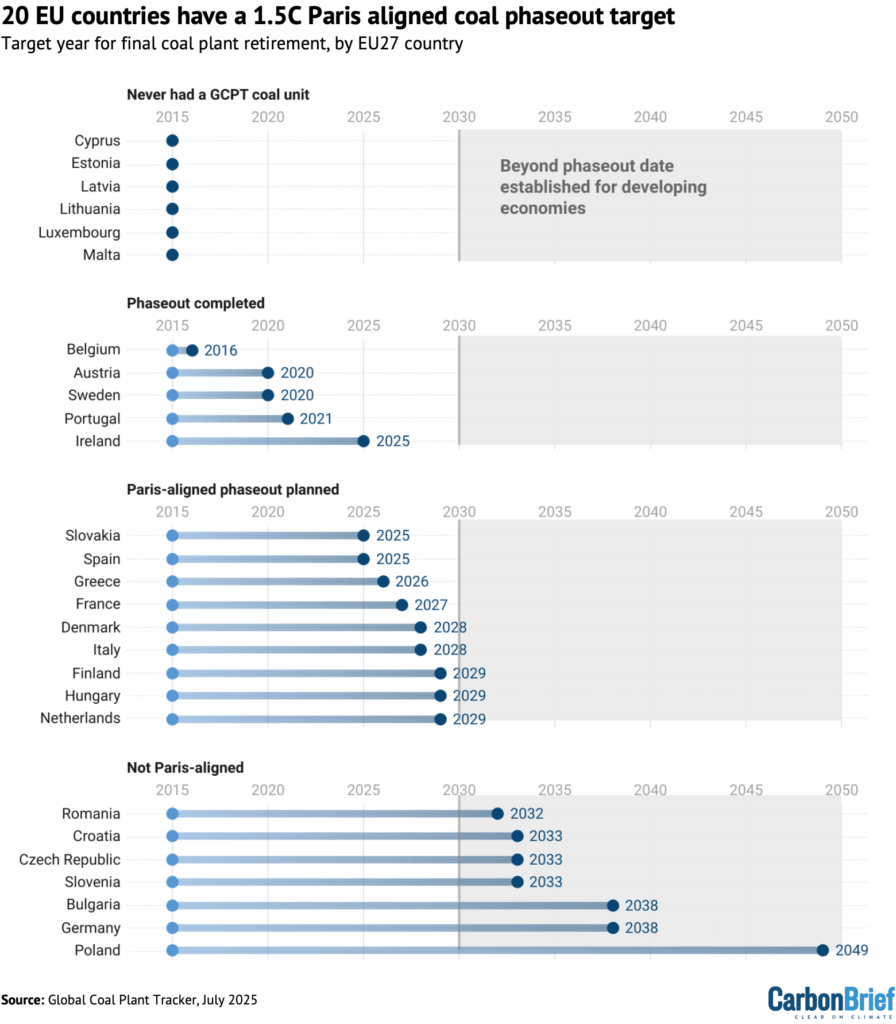
Development has also ceased in the region. No new coal plants have been proposed in the EU since 2018 and no coal plants have entered construction since 2019.
The coal phaseout in the EU and UK has been driven by a combination of country commitments and supporting policies and regulations, including air and carbon pollution limits on power plants, carbon pricing and policy support for clean-energy deployment.
Coal-power capacity retirements in the EU stalled for two years, following gas shortage concerns in the wake of Russia’s invasion of Ukraine, but they have since accelerated.
Coal capacity retired in the first half of 2025 (2.5GW) has already nearly exceeded all of 2023 (2.7GW) – with another 11GW planned for retirement in the EU by the end of the year.
GEM data shows that, in Latin America, the shelving of two coal-plant proposals in Honduras and Brazil in 2025 has left the region with no new coal plants actively proposed, as shown in the chart below – a collapse of the 18 plants totalling 7.3GW of capacity proposed in 2015.
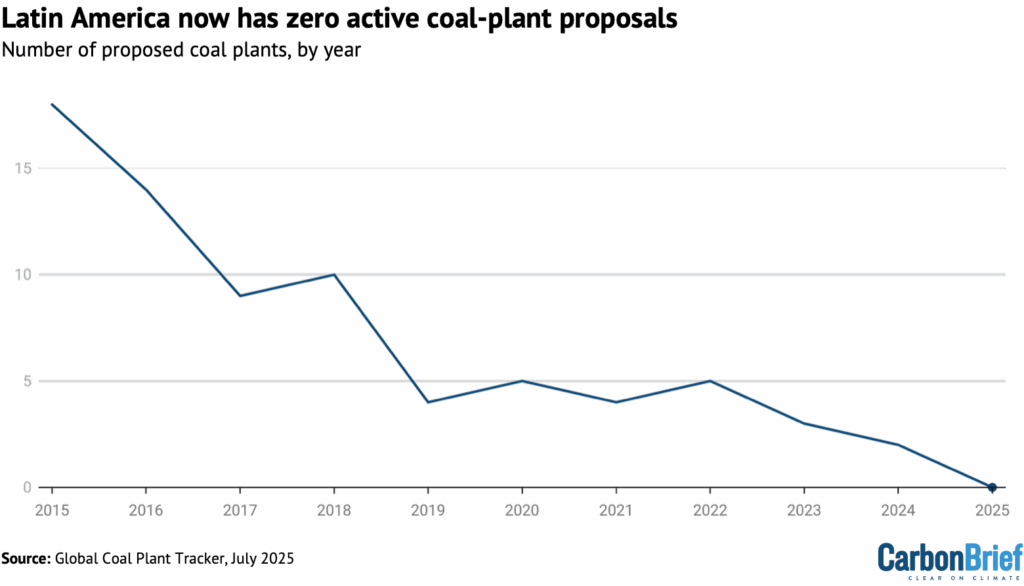
This followed the entry of Honduras into the Powering Past Coal Alliance (PPCA) in May and the lack of new coal plants proposed in Brazil’s 2025 national energy auctions, with a decrease in coal-power generation projected through 2034 in Brazil’s most recent 10-year energy plan.
Latin America is also nearly on track for a coal-power pathway that would be aligned with the 1.5C target of the Paris Agreement. More than 60% (10GW) of its 16.3GW of operating coal-power capacity is scheduled to come offline by 2040.
China and India continue to dominate
China and India dominated coal development in the first half of 2025, as the two countries had more new proposals, construction starts and coal plants commissioned than the rest of the world combined, GEM’s tracker shows.
As the chart below shows, there were 74.7GW and 12.8GW of newly proposed coal projects in China and India, respectively, in the first half of 2025, compared to just 11GW in the rest of the world.
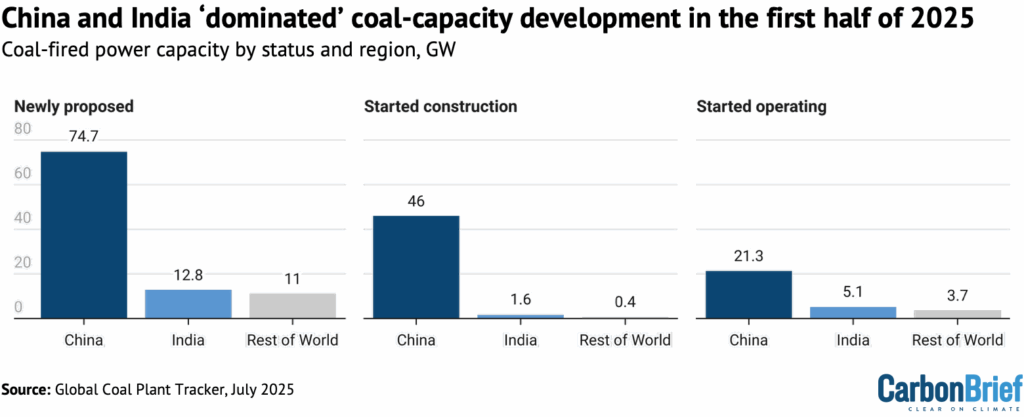
Construction starts and restarts in China also reached 46GW, putting the country on track to match the record levels of 2024, when more than 97GW of coal-power plants began construction.
As discussed in GEM’s recent joint report with the Centre for Research on Energy and Clean Air (CREA), major coal-producing provinces, including Xinjiang, Inner Mongolia, Shandong and Shaanxi, are among the provinces commissioning and building the most new coal power, as shown in the chart below.
This expansion is backed by established permitting pathways, strong local power companies and a reliable flow of investment.
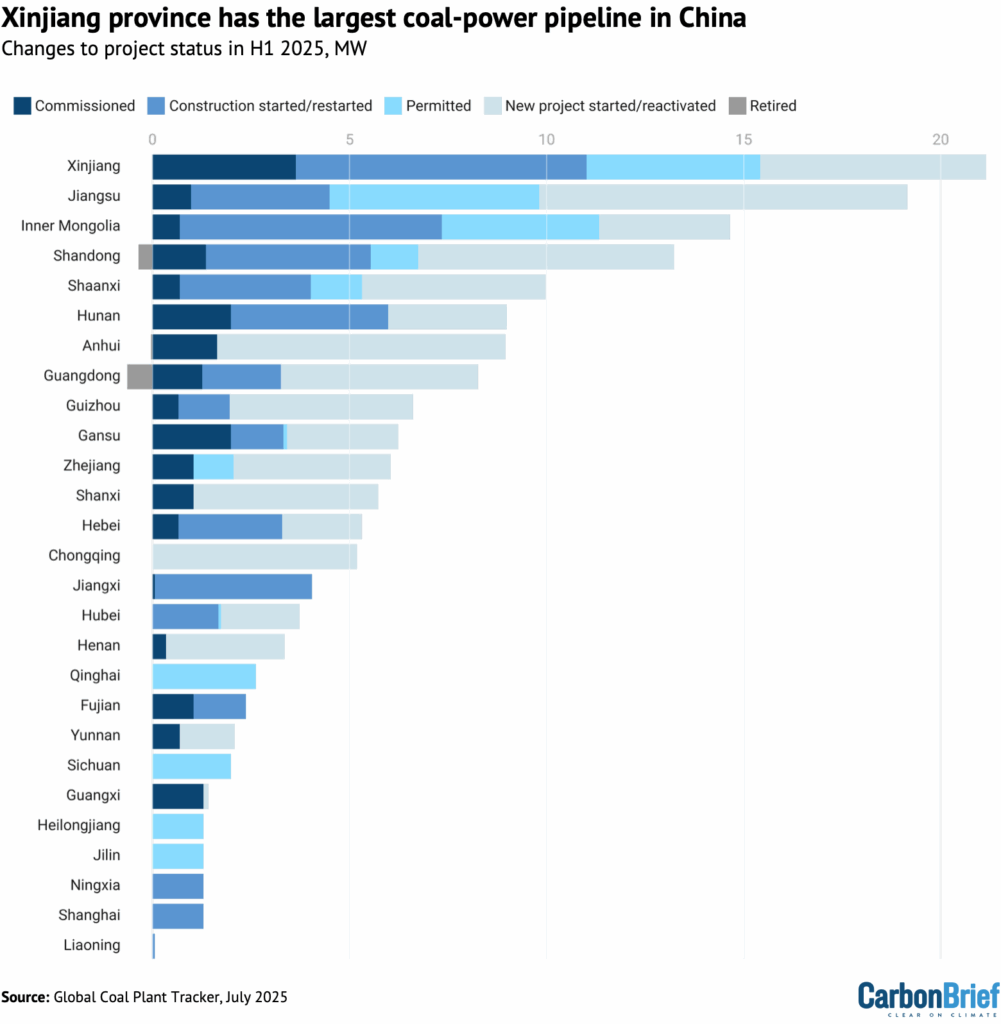
Yet, China has also been installing record amounts of clean energy, with more than 500GW of solar and wind power expected to come online in 2025. The increased generation from solar and wind power exceeded the increase in power demand in the first half of 2025, helping drive down China’s CO2 emissions by 1% compared to last year.
As clean energy has gained growing significance in China’s energy mix, more attention is being placed on renewables’ role in energy security and on coal power’s future as a flexible, supporting resource rather than as a primary generator.
Despite this narrative shift, coal remains deeply embedded in China’s power system, with little public discussion of its phasedown or eventual exit.
Coal-plant development is also on the rise in India, GEM’s tracker shows.
Commissioning of new coal plants in the country in H1 2025 (5.1GW) has already exceeded all of last year (4.2GW), as shown in the chart below.
Proposed coal-power capacity in India has also been on the rise, led by a record 38.4GW of coal-plant proposals in 2024 – driving up proposed coal capacity to over 92GW as of July 2025.
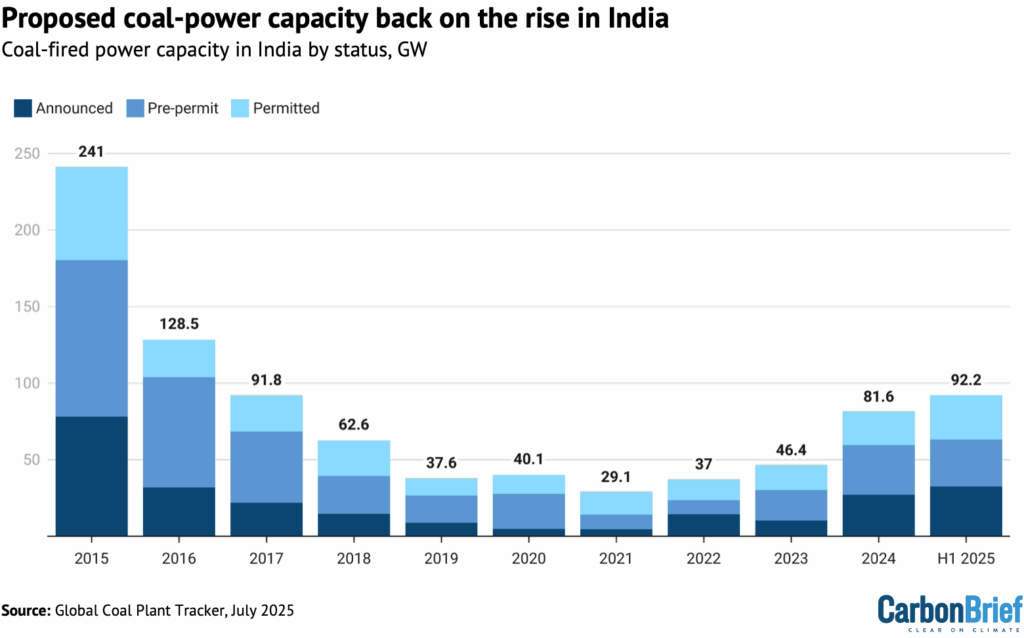
Retirements also remained sluggish in India, with 0.8GW retired in H1 2025 and just 0.2GW retired in 2024 and 2023, according to GEM’s tracker.
The decline follows 2023 guidance by India’s Central Electricity Authority (CEA) advising power utilities not to retire any thermal power capacity until 2030. In 2025, the country’s environment ministry again delayed long-pending sulfur dioxide regulations on coal plants.
Yet India also added more than 28GW of wind and solar power in 2025, a nearly 50% increase over the previous year. Despite the growth, the Indian government has stated that it is planning a coal expansion, with coal use not projected to peak until 2040, according to India’s Ministry of Coal.
In both China and India, coal retains its policy support, with clean energy framed, not as a replacement, but as a supplement – reinforcing a dual-track energy strategy that postpones difficult decisions on coal phaseout.
The US goes big on ageing coal plants
Like China and India, the US under President Donald Trump is also supporting coal power. Unlike China and India, however, the US has reversed course on clean energy in the first half of 2025.
During his tenure, former US president Joe Biden reached an agreement with other G7 nations to phase out coal power by 2035, offered incentives for clean energy under the Inflation Reduction Act (IRA) and moved to finalise pending power plant regulations – effectively helping replace the nation’s ageing coal plants with lower-cost solar and wind power while boosting domestic cleantech manufacturing.
The Trump administration has moved to derail Biden’s agenda by phasing out the clean energy tax credits, repealing coal plant regulations and slowing or halting solar and wind power permitting and financing.
It has also been using “emergency powers” to keep coal plants online, racking up $29m in costs to extend the life of Michigan’s Campbell plant through the summer – costs the utility is seeking to pass on to ratepayers for power the grid operator said was not needed.
Despite the political support for coal, the US remains on track to retire more coal power in 2025 than in 2024, with 3.7GW retired as of July.
Whether this trend continues in an increasingly uncertain environment for clean energy remains to be seen, as plant closures are often part of long-term plans and economic considerations, usually extensively negotiated with state regulators and based on broader considerations than just current federal policy.
In all, US utilities are slated to close nearly 100GW of coal capacity by 2035, as shown in the chart below. By then, the average age of a US coal plant will be 55 years.
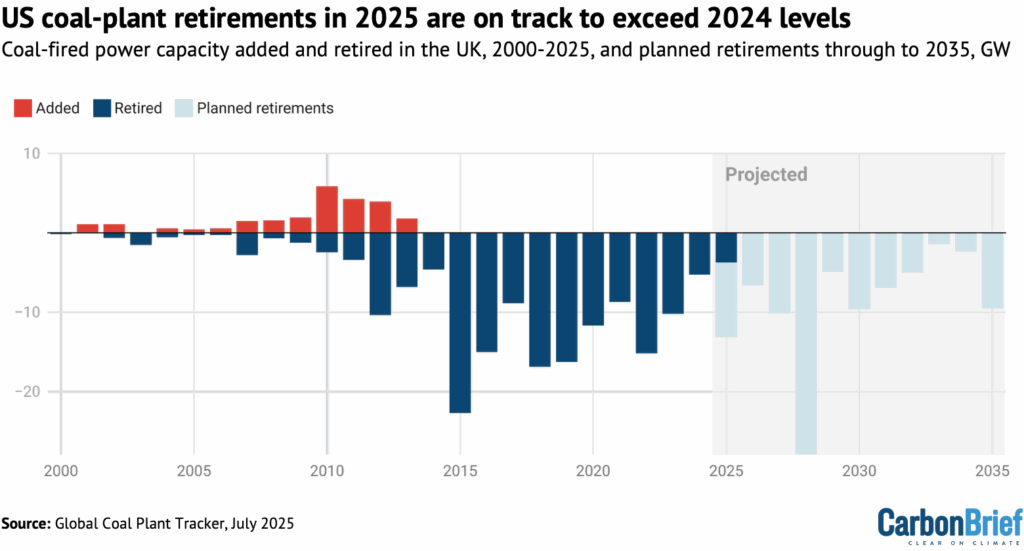
The US also saw a new coal plant proposal in H1 2025, bringing the total to three proposals according to GEM’s tracker, the most of any OECD country. All three plan to incorporate carbon capture and storage, although none have the necessary permits for construction.
Just energy transition partnerships advance despite hurdles
Despite delayed documentation, ongoing negotiations and the withdrawal of the US from International Partner Group participation, JETP agreements in Vietnam, Indonesia and South Africa are all continuing to progress.
In Vietnam, three clean-energy investment projects have officially penned financing agreements as of July 2025, getting the country one step closer to mobilising JETP capital.
Just a few months prior, Vietnam released an adjustment to its latest power development plan, which featured substantial increases in projected wind and solar capacity and a modest increase in projected hydropower capacity.
However, the plan also includes a 1GW increase in projected coal power by 2030, as shown in the chart below.
The new figure for peak coal, 31.1GW, coincides with the interest from state-owned utility EVN to revive a coal plant previously considered to be cancelled.

In Indonesia, the release of the latest electricity supply business plan (RUPTL 2025–2034) in May 2025 resulted in a spike in new and revived proposals for on-grid coal capacity. This was alongside the continued growth of off-grid, captive-coal plant proposals to power industrial areas, as GEM’s tracker shows.
Accounting for these captive-coal plants in Indonesia’s JETP documentation has presented a challenge, but Indonesia’s JETP secretariat has reiterated that updates to the country’s JETP comprehensive investment and policy plan are ongoing through the first six months of 2025 to address emissions from captive plants and incorporate efficiency targets.
Disparity remains between the government’s stated renewable energy ambitions and the reality of present advancements at the project level. Presidential regulation 112/2022 targets a 2050 national coal phaseout date in Indonesia and President Prabowo Subianto has more recently made overtures to an even faster 2040 coal phaseout.
Meanwhile, Indonesia’s proposed coal-power capacity grew by 5.1GW in H1 2025, to 17.1GW overall, as shown in the chart below.

In South Africa, the government has also reiterated its commitment to its JETP agreement. While Vietnam and Indonesia have substantial numbers of recently built coal plants and plants in continued development, South Africa operates a fleet of old, unreliable coal plants.
World Bank-linked funding for South Africa’s energy transition was approved in June 2025. While solidifying a climate investment fund, the plan also included the delayed closure of three coal plants that already average more than 50 years of age (Camden, Hendrina and Grootvlei).
All three countries are continuing down the dual paths of simultaneously extending coal’s lifetime and maintaining just energy transition commitments, banking on “all of the above” approaches and, ultimately, causing misalignment with JETP principles.
Yet, the continued progress of their just energy transition programs, despite global political and economic volatility, is a strong indicator that policy and planning priorities could soon align towards the phaseout of coal.
The post Guest post: China and India account for 87% of new coal-power capacity so far in 2025 appeared first on Carbon Brief.
Guest post: China and India account for 87% of new coal-power capacity so far in 2025
Greenhouse Gases
Scientists are ‘most trusted’ source of climate information in global-south survey
Scientists are the most trusted source of information for climate change in some of the largest global-south countries, ranking above newspapers, friends and social media.
This is according to a survey of 8,400 people across Chile, Colombia, India, Kenya, Nigeria, South Africa and Vietnam, the results of which have been published in Nature Climate Change.
The study finds that trusting and paying attention to climate scientists was associated with increased climate knowledge, roughly twice the effect size associated with a college degree.
One scientist who was not involved in the research says the findings suggest there is an opportunity to “bolster climate knowledge” in the global south by widening access to climate science information.
When asked to rank how important climate change is for their country, participants rated the issue as high, with the average score for each country above 4.4.
However, when asked to rank the importance of climate change compared to other key social issues, respondents – on average – ranked taking action on climate change ninth out of 13, after improving healthcare, decreasing corruption and increasing employment.
Another expert not involved in the study says the results highlight a “crucial tension” between “strong” public concern about climate change and the perception that other social issues should take priority when allocating “scarce” public resources.
Global-south focus
The impacts of climate change are disproportionately felt by the poorest members of society, who often live in the global south.
Nevertheless, Dr Luis Sebastian Contreras Huerta – a researcher in experimental psychology at Chile’s Universidad Adolfo Ibanez – tells Carbon Brief that research on climate attitudes has been “heavily biased” toward the global north.
Voices from the global south are “often invisible in science”, he adds.
Huerta was not involved in the study, but has published research using surveys to assess public beliefs about climate change. He describes the new study – which is evenly distributed across Chile, Colombia, India, Kenya, Nigeria, South Africa and Vietnam – as “a valuable attempt to capture public views across Latin America, Africa and Asia”.
The seven countries featured in the research include six of the 20 largest in the global south and range from “the lower end of low-to-middle-income countries (Nigeria) to the low end of high-income countries (Chile)”, according to the study.
The survey was administered online by polling company YouGov between April and May 2023. Respondents could answer in English or in other “country-specific languages”. For example, respondents in Chile and Colombia had the option to carry out the survey in Spanish, while those in India could answer in Hindi.
Trust and attention
The authors asked survey respondents to rank 12 different sources of information about climate change, based on the attention they pay it and how much they trust it.
The average rankings are shown in the table below, where one indicates the highest level of attention or trust and 12 indicates the lowest.

The table shows that, on average, scientists are ranked the highest for both trust and attention.
The country-specific results show that scientists rank the highest in trust in every country except Vietnam, where they rank second highest after television programmes. Meanwhile, friends and religious leaders rank the lowest for trust.
Huerta says it is “encouraging” that the general public “tend to trust scientists as their main source of information”.
However, he warns Carbon Brief about “social desirability” – a phenomenon in which people respond to surveys in a way that they think will be viewed favourably by others. In this case, it means that “people may report higher trust in scientists and less reliance on social media than they actually practice”, Huerta explains.
Dr Charles Ogunbode is an assistant professor in applied psychology at the University of Nottingham. He is not involved in the paper, but has carried out research on public perceptions of climate change.
He tells Carbon Brief that the relatively low attention and trust shown to family and friends is a “remarkable finding that stands in contrast with conventional knowledge”. He continues:
“Previous psychological research on this topic (generally predominated by western samples) would support an expectation that people would have greater trust in interpersonal social referrents like friends and family…
“I think the findings from the study signal an opportunity to bolster climate knowledge in the global south by widening access to scientific information on climate change.”
Climate knowledge
The survey also assesses the level of climate knowledge of the respondents, by asking them to identify whether a series of statements are true, false, or if they are “not sure”.
More than 80% of respondents correctly identified that the following two statements are correct:
- Climate change is mainly caused by human activities.
- Warming leads to more extreme events, such as droughts, floods and storms.
Conversely, fewer than 20% of people correctly identified the following two statements as false:
- Nuclear power plants emit CO2 during operations.
- Today’s global CO2 concentration has occurred in the past 650,000 years.
Knowledge about climate change was “quite similar” across countries, according to the survey. However, the authors found that women are more likely to respond “not sure” than men.
The study finds that trusting and paying attention to climate scientists was associated with increased climate knowledge, roughly twice the effect size associated with a college degree.
Policy comparison
Early in the survey, respondents were asked to rank how important climate change is for their country on a scale from one to five. On average, all countries ranked climate change above 4.4 on this scale.
However, the survey later asked respondents to rank the 13 government programmes, including climate, healthcare and education, in order of importance.
The authors found that “addressing climate change” ranks at ninth, on average, across the seven countries.
Climate change ranks the highest in Vietnam, where it comes in second behind “decreasing political corruption”.
However, it ranks 10th in Nigeria and South Africa, beating only “improving public transport”, “improving access to credit” and “getting Covid-19 under control”.
Lead author Prof Richard Carson, a professor of economics at the University of California, tells Carbon Brief that asking respondents to rank different issues “provides a much richer picture of the structure of public opinion on climate issues” than asking them to rank issues separately. This, he says, is because it forces respondents to make “direct tradeoffs”.
The survey shows that “people might say that dealing with climate change matters – but this does not mean that they would place it on the leaderboard when it comes to priorities”, he adds.
Huerta – the experimental psychology researcher – tells Carbon Brief that results highlight “a crucial tension”. He explains:
“Athough people show strong concern for climate change, when it comes to allocating scarce public resources, priorities such as health, education, poverty reduction, and security often come first.”
He adds:
“People may genuinely care, but without clear, immediate benefits, climate action is often deprioritised – unlike issues such as air pollution, where the consequences and gains are more tangible.”
The authors also asked survey respondents to rank seven “health-related issues”, with respiratory problems consistently identified as the highest priority.
Huerta says the results show a “disconnection”, adding:
“People rank respiratory illness as a top health concern, but they do not always connect it with climate change more broadly. This highlights a key communication challenge for climate policy.”
Finally, the authors asked respondents to rank their preference for the use of a carbon tax. In keeping with the results above, “spend on education and health” ranks top of the list. This is followed by subsidising solar panels and investing in “clean research and development”.
Dr Stella Nyambura Mbau is a lecturer at Kenya’s Jomo Kenyatta University of Agriculture and Technology and was not involved in the study. She tells Carbon Brief that “the preference for earmarking carbon tax revenue for health, education and renewable energy subsidies aligns with community-based adaptation strategies, such as solar-powered solutions, that address immediate needs while building resilience”.
She suggests that prioritising policies that can tackle climate change alongside other social issues could “bridge the gap between climate action and local priorities”.
Next steps
The authors note that their survey could only be completed by people with access to the internet, meaning that it “systematically underrepresents those with lower income, living in rural areas and who are older”.
Only people over the age of 18 were allowed to complete the survey. Across the countries, the median age of respondents was 31 years old. There was also a slight skew towards men, who made up 55% of the respondents.
As such, some external experts pointed out that results could be skewed.
For example, Prof Tarun Khanna, a professor at Harvard Business School, notes that when ranking uses for carbon taxes, there was low support for policies such as returning money to the poor. He questions whether this could be “because the survey concentrates on a relatively affluent class of people”.
Dr Nick Simpson is chief research officer at the University of Cape Town‘s African Climate and Development Initiative Climate Risk Lab and has led separate research on general public perceptions of climate change in Africa.
He praises the study’s “large, cross-national dataset” and “rigorous statistical techniques”. However, he adds:
“The survey questions focus primarily on mitigation [greenhouse gas emissions prevention and reduction] responsibilities, reflecting a global north bias in climate surveys. [The questions] do not fully capture urgent adaptation concerns or the lived realities of climate vulnerability in low and middle-income countries.”
Future research should incorporate more “adaptation-specific questions” in order to “provide a more holistic understanding of climate action priorities”, he says.
The post Scientists are ‘most trusted’ source of climate information in global-south survey appeared first on Carbon Brief.
Scientists are ‘most trusted’ source of climate information in global-south survey
-
Climate Change2 years ago
Spanish-language misinformation on renewable energy spreads online, report shows
-
Climate Change Videos2 years ago
The toxic gas flares fuelling Nigeria’s climate change – BBC News
-

 Greenhouse Gases1 year ago
Greenhouse Gases1 year ago嘉宾来稿:满足中国增长的用电需求 光伏加储能“比新建煤电更实惠”
-

 Climate Change1 year ago
Climate Change1 year ago嘉宾来稿:满足中国增长的用电需求 光伏加储能“比新建煤电更实惠”
-

 Carbon Footprint1 year ago
Carbon Footprint1 year agoUS SEC’s Climate Disclosure Rules Spur Renewed Interest in Carbon Credits
-
Climate Change2 years ago
Why airlines are perfect targets for anti-greenwashing legal action
-
Climate Change1 month ago
Guest post: Why China is still building new coal – and when it might stop
-
Renewable Energy2 months ago
US Grid Strain, Possible Allete Sale





